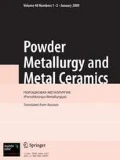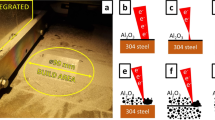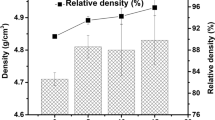In this study, highly porous pure aluminum material with cellular structure was fabricated via powder metallurgy route using a space holding technique with the addition of boric acid powders as pore-forming agents. Boron products, namely, the boric acid, were used as novel pore-forming agents. Aluminum powders with high porosity of ~50% were successfully produced. The experiments were focused on investigating the effects of such parameters as compaction pressure and sintering temperature on the final properties of fabricated samples by determining their optimum values. Quasistatic compressive behaviors of the obtained highly porous materials were examined at a strain rate of 10–3 sec–1. The results show that the most suitable compressive properties of the highly porous states were obtained for the samples cold-pressed under 630 MPa and sintered at 620°C for 3 hours. According to the stress-strain behavior of the high-porous states, there is a plateau region with nearly constant flow stress and a large strain of about 70%. The densities of these high porous states were approximately 1.0 g/cm3, and the mean cell sizes amounted to about 0.6 mm. Using boric acid (H3BO3) powders differs from conventional processes in terms of superior comprehensive mechanical properties with static compressive strength and energy absorption of 18 MPa, and 12 MJ/m3, respectively.









Similar content being viewed by others
References
A.G. Evans, J.W. Hutchinson, and M.F. Ashby, “Multifunctionality of cellular metal systems,” Prog. Mater. Sci., 43, 171–221 (1999); DOI: https://doi.org/10.1016/S0079-6425(98)00004-8.
J. Banhart, “Manufacture, characterization and application of cellular metals and metal foams,” Prog. Mater. Sci., 46, 559–632 (2001); DOI: https://doi.org/10.1016/S0079-6425(00)00002-5.
L.J. Gibson and M.F. Ashby, Cellular Solids, Structure and Properties, Second ed., Cambridge University Press, Cambridge, UK (1997).
Y. Yamada, K. Shimojima, Y. Sakaguchi, M. Mabuchi, M. Nakamura, T. Asahina, T. Mukai, H. Kanahashi, and K. Higashi, “Compressive properties of open-cellular SG91AA1 and AZ91 Mg,” Mater. Sci. Eng., A272, 455–458 (1999).
Y. Yamada, K. Shimojima, Y. Sakaguchi, M. Mabuchi, M. Nakamura, T. Asahina, T. Mukai , H. Kanahashi, and K. Higashi, “Processing of an open-cellular AZ91 magnesium alloy with a low density of 0.05 g/cm3,” Mater. Sci. Lett., 18, 1477–1480 (1999); DOI: https://doi.org/10.1023/A:1006677930532.
M.F. Ashby, T. Evans, N.A. Fleck, L.J. Gibson, J.W. Hutchinson, and H.N.G. Wadley, “Metal Foams: A Design Guide,” Elsevier, 2000.
S.V. Gnyloskurenko, T. Nakamura, A.V. Byakova, Y.M. Podrezov, R. Ishikawa, and M. Maeda, “Development of lightweight Al alloy and technique,” Canadian Metallurgical Quarterly, 44, No. 1, 7–12 (2005); DOI: https://doi.org/10.1179/000844305794409742.
V.I. Shapovalov, “Method for manufacturing porous articles,” U.S. Patent No. 5,181,549 (1993).
C.J. Yu and J. Banhart, “Mechanical properties of metallic foams,” in: Proceedings Fraunhofer USA Metal Foam Symposium (1997), pp. 37–48.
B. Jiang, N.Q. Zhao, C.S. Shi, X.W. Du, J.J. Li, and H.C. Man, “A novel method for making open cell aluminum foams by powder sintering process,” Mater. Lett. 59, 3333–3336 (2005); DOI: https://doi.org/10.1016/j.matlet.2005.05.068.
M. Bram, C. Stiller, H.P. Buchkremer, D. Stöver, and H. Baur, “High-porosity titanium, stainless steel, and superalloy parts,” Adv. Eng. Mater., 2, 196–199 (2002); DOI: https://doi.org/10.1002/(SICI)1527-2648(200004)2.
C.E. Wen, M. Mabuchi, Y. Yamada, K. Shimojima, Y. Chino, and T. Asahina, “Processing of biocompatible porous Ti and Mg,” Scr. Mater., 45, 1147–1153 (2001); DOI: https://doi.org/10.1016/S1359-6462(01)01132-0.
A. Laptev, M. Bram, H.P. Buchkremer, and D. Stöver, “Study of production route for titanium arts combining very high porosity and complex shape,” Powder Metall., 47, 85–92 (2004); DOI: https://doi.org/10.1179/003258904225015536.
H.I. Bakan, “A novel water leaching and sintering process for manufacturing highly porous stainless steel,” Scr. Mater., 55, 203–206 (2006); DOI: https://doi.org/10.1016/j.scriptamat.2006.03.039.
A. Byakova, A. Sirko, K. Mykhalenkov, Yu. Milman, S. Gnyloskurenko, and T. Nakamura, “Improvements in stabilisation and cellular structure of Al based foams with novel carbonate foaming agent,” High Temper. Mater. Proc. 26, No. 4, 239–246 (2007); DOI: https://doi.org/https://doi.org/10.1515/HTMP.2007.26.4.239.
T. Koizumi, K. Kido, K. Kita, K. Mikado, S. Gnyloskurenko, and T. Nakamura, “Method of preventing shrinkage of aluminum foam using carbonates,” Metals, 2, 1–9 (2012); DOI: https://doi.org/10.3390/met2010001.
Alexandra Byakova, Iegor Kartuzov, Svyatoslav Gnyloskurenko, Takashi Nakamura, “The role of foaming agent and processing route in mechanical performance of fabricated aluminum foams,” Adv. Mater. Sci. Eng., 4, 1–9 (2014); DOI: https://doi.org/10.1155/2014/607429.
S.Y. Guven, “Powder metallurgy and metallic foams,” J. Techn. Sci., 1, No. 2, 22–28 (2011).
I. Yavuz, S.M. Baspinar, and H. Bayrakceken, “Use of metallic high porous state materials in vehicles,” Electronic J. Vehicle Technol., 3, 43–51 (2009).
M. Alizadeh and M. Mirzaei-Aliabadi, “Compressive properties and energy adsorption behavior of Al–Al2O3 composite foams synthesized by space-holder technique,” Mater. Design., 35, 419–424 (2012); DOI: https://doi.org/10.1016/j.matdes.2011.09.059.
R. Surace and L.A.C. De Filippis, “Investigation and comparison of aluminum foams manufactured by different techniques,” Adv. Knowledge Appl. Practice, 1, 95–118 (2010); DOI: https://doi.org/10.5772/10353.
Boric Oxide, Boric Acid, and Borates, in: Kirk-Othmer Encyclopedia of Chemical Technology, 4 (2001), pp. 187–212.
H. Kolsky, “An investigation of the mechanical properties of materials at very high rates of loading,” Proc. R. Soc., B62, 676 (1949).
K.A. Dannemann Jr. and J. Lankford, “High strain rate compression of closed cell aluminum foams,” Mater. Sci. Eng. A, 293, 157–164 (2000); DOI: https://doi.org/10.1016/S0921-5093(00)01219-3.
H. Bafti and A. Habibolahzadeh, “Production of aluminum high porous state by spherical carbamide space holder technique-processing parameters,” Mater. Design., 31, Issue 9, 4122–4129 (2010); DOI: https://doi.org/10.1016/j.matdes.2010.04.038.
Y.Y. Zhao and D.X. Sun, “A novel sintering-dissolution process for manufacturing Al foams,’ Scr. Mater., 144, 105–110 (2000); DOI: https://doi.org/10.1016/S1359-6462(00)00548-0.
S. Ramachandra, P.S. Kumar, and U. Ramamurty, “Impact energy absorption in Al foam at low velocities,” Scr. Mater., 49, 741–745 (2003); DOI: https://doi.org/10.1016/S1359-6462(03)00431-7.
S. Okuma, “Sintering mechanism of aluminum, and the anodization of aluminum sintered bodies,” Electrocomp. Sci. Technol., 6, No. 1, 23–29 (1979); DOI: https://doi.org/10.1155/APEC.6.23.
P. Kenesei, Cs. Kádár, Zs. Rajkovits, and J. Lendvai, “The influence of cell-size distribution on the plastic deformation in metal foams,” Scr. Mater., 50, 295–300 (2004); DOI: https://doi.org/10.1016/j.scriptamat.2003.09.046.
A. Kim, M.A. Hasan, S.H. Nahm, and S.S. Cho, “Evaluation of compressive mechanical properties of Alfoams using electrical conductivity,” Comp. Struct. 71, No. 2, 191–198 (2005); DOI: https://doi.org/10.1016/j.compstruct.2004.10.016.
Z. Wang, J. Shen, G. Lu, and L. Zhao, “Compressive behavior of closed-cell aluminum alloy foams at medium strain rates,” Mater. Sci. Eng. A, 528, 2326–2330 (2011); DOI: https://doi.org/10.1016/j.msea.2010.12.059.
D.P. Papadopoulos, I.Ch. Konstantinidis, N. Papanastasiou, S. Skolianos, H. Lefakis, and D.N. Tsipas, “Mechanical properties of Al metal foams,” Mater. Lett., 58, 2574–2578 (2004); DOI: https://doi.org/10.1016/j.matlet.2004.03.004.
E. Simone and L.J. Gibson, “Effects of solid distribution on the stiffness and strength of metallic foams,” Acta Mater., 46, No. 6, 2139–2150 (1998); DOI: https://doi.org/10.1016/S1359-6454(97)00421-7.
A. Hassani, A. Habibolahzadeh, and H. Bafti, “Production of graded aluminum foams via powder space holder technique,” Mater. Design., 40, 510–515 (2012); DOI: https://doi.org/10.1016/j.matdes.2012.04.024.
G. Ryan, A. Pandit, and D.P. Apatsidis, “Fabrication methods of porous metals for use in orthopaedic applications,” Biomaterials, 27, 2651–2670 (2006); DOI: https://doi.org/10.1016/j.biomaterials.2005.12.002.
B. Jiang, N.Q. Zhao, C.S. Shi, X.W. Du, J.J. Li, and H.C. Man, “A novel method for making open cell aluminum foams by powder sintering process,” Mater. Lett., 59, 3333–3336 (2005); DOI: https://doi.org/10.1016/j.matlet.2005.05.068.
M. Mirzaee, R. Changizi, and B. Alinejad, “Comparison of mechanical and electrical properties of foams fabricated by the methods of sinter followed cold press and hot press,” ARPN J. Eng. Appl. Sci., 7, 1533–1538 (2012).
Acknowledgements
This project was financially supported by Eskisehir Osmangazi University, Research Foundation (project No: 201215010), Eskisehir, Turkey.
Author information
Authors and Affiliations
Corresponding author
Additional information
Published in Poroshkova Metallurgiya, Vol. 59, Nos. 11–12 (536), pp. 61–72, 2020.
Rights and permissions
About this article
Cite this article
Korpe, N.O., Dürger, N.B., Dur, D. et al. Effects of Compacting Pressure and Sintering Temperature on the Properties of Highly Porous Pure Aluminum Produced with Boric Acid (H3BO3). Powder Metall Met Ceram 59, 661–671 (2021). https://doi.org/10.1007/s11106-021-00201-9
Received:
Published:
Issue Date:
DOI: https://doi.org/10.1007/s11106-021-00201-9




